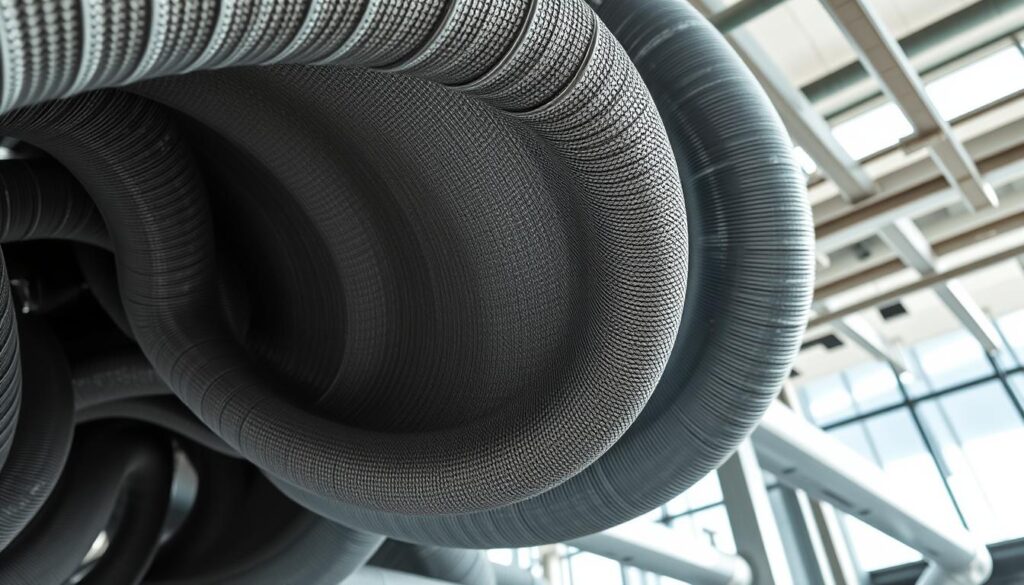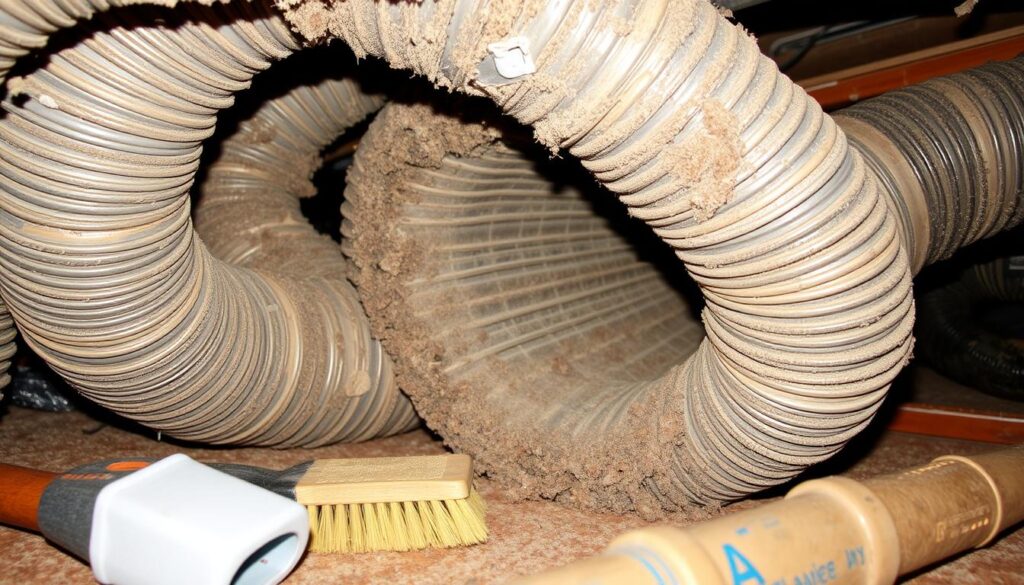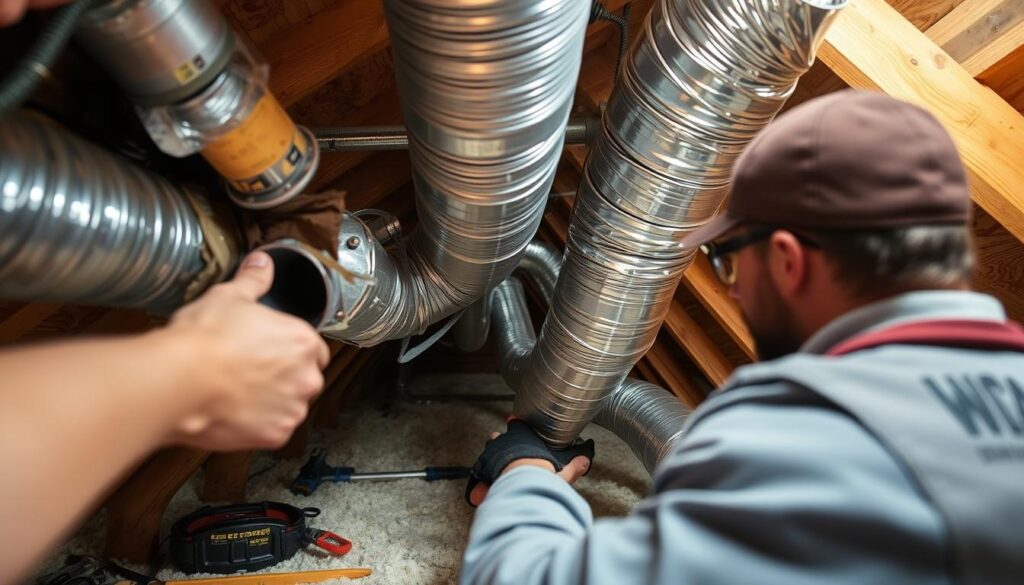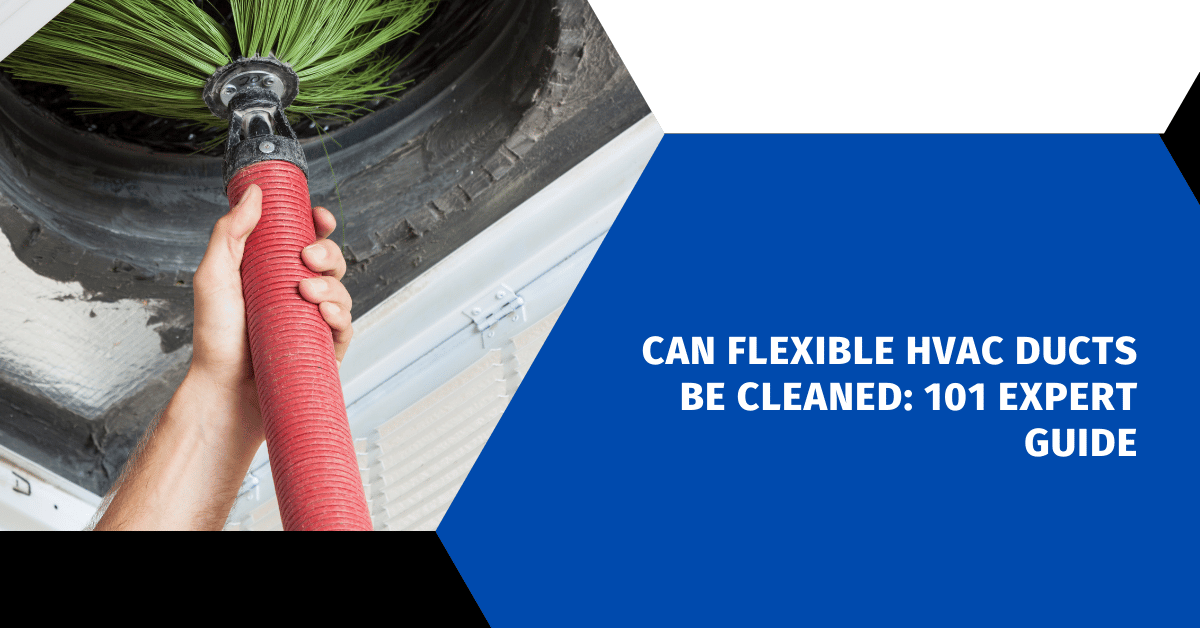Affiliate Disclosure
HVAC Guide Guys is a participant in the Amazon Services LLC Associates Program, an affiliate advertising program designed to provide a means for sites to earn advertising fees by advertising and linking to Amazon.
Can Flexible HVAC Ducts Be Cleaned? Homeowners often overlook the hidden ducts that move air in our homes. But can flexible HVAC ducts be cleaned, or do they need to be replaced? This guide dives into the world of flexible ductwork. It covers maintenance, cleaning methods, and how to keep the air in your home clean.

Key Takeaways
- Flexible HVAC ducts can be cleaned, but the process requires specialized equipment and techniques.
- Professional duct cleaning services may be more effective than DIY methods in dislodging contaminants.
- Regularly changing air filters and addressing moisture issues can help maintain the cleanliness of flexible ducts.
- Factors like duct age, damage, and accessibility can determine whether cleaning or replacement is the better option.
- Proper maintenance is crucial to ensure the longevity and efficiency of flexible HVAC ductwork.
Table of Contents
Understanding Flexible HVAC Ductwork Basics
Flexible ductwork is a popular choice for HVAC systems. It’s made to fit in tight spaces easily. This makes it a great option for many homeowners and contractors. Let’s look at what flexible HVAC ductwork is, its benefits, and its limitations.
What Are Flexible Ducts Made Of?
Flexible ducts have a steel wire spiral inside a bendable polymer. This can be polyethylene or reinforced vinyl. They also have insulation, like fiberglass, to keep heat in or out. The outside is tough to prevent damage.
Where Flexible Ducts Are Commonly Used
Flexible ducts are great for tricky spots. They work well around staircases, in tight spaces, and in attics and crawl spaces. They’re also good for homes and small businesses because they’re easy to use and cost-effective.
Benefits and Limitations of Flex Ducts
Flexible ducts are easy to install and improve airflow. They fit into unique spaces well. But, they can get damaged or dirty over time. Some worry about air leaks and less efficiency with them.
Knowing about flexible HVAC ductwork is key. It helps homeowners and HVAC pros make smart choices. By understanding materials, uses, and pros and cons, you can pick the right ductwork for your system.
Explore Our HVAC Shop
Looking for top-rated HVAC tools, parts, and accessories? Visit our shop and find the perfect solution for your needs.
Visit the ShopCan Flexible HVAC Ducts Be Cleaned
Whether flexible HVAC ducts can be cleaned is a topic of debate. Experts have different views on their effectiveness and safety. It’s not a simple yes or no answer.
Some say cleaning these ducts is hard because of their flexible design. The accordion-style can trap dirt, making it tough to clean. There’s also a risk of damaging the ducts during cleaning.
Others believe that with the right tools and methods, cleaning is possible. They use powerful vacuums, brushes, and special solutions to remove dirt and pollutants.
The success of flex duct cleaning depends on the cleaning service’s expertise. It’s important to have professionals who know how to handle these ducts without causing harm.
Whether to clean or replace ducts depends on several factors. These include the ducts’ age, condition, contamination level, and HVAC maintenance needs.
“Proper duct cleaning requires specialized equipment and training to effectively clean flexible ducts without causing damage. It’s important to work with experienced professionals who understand the unique challenges of these systems.”
Explore Our HVAC Shop
Looking for top-rated HVAC tools, parts, and accessories? Visit our shop and find the perfect solution for your needs.
Visit the ShopProfessional Opinions on Flex Duct Cleaning
Opinions on cleaning flexible HVAC ducts vary widely. Some say flex ducts can’t be cleaned and need to be replaced. Others claim they can be cleaned with special methods like rotary brushes or vacuum trucks.
Duct Cleaners’ Perspectives
Many duct cleaners think flex ducts are too delicate for cleaning. They worry that cleaning equipment could damage them. The design of flex ducts also makes it hard to clean every part.
Air Quality Consultants’ Viewpoint
Air quality consultants often doubt cleaning flex ducts. They say the duct material is too porous and some areas are hard to reach. This could leave dust and allergens inside, harming air quality.
Industry Expert Recommendations
Some experts believe flex ducts can be cleaned with the right tools. They suggest using rotary brushes with cameras and powerful vacuum trucks. These tools can clean without harming the ducts.
| Cleaning Method | Negative Pressure Rating | Suitability for Flex Ducts |
|---|---|---|
| Portable negative air duct cleaning machines | 5 IWC | Not recommended due to excessive negative pressure |
| Truck-mounted negative air duct cleaning machines | 20 IWC and higher | Not recommended due to excessive negative pressure |
| Rotary brushes with integrated cameras | Minimal negative pressure | Recommended for cleaning flexible ducts |
| High-powered vacuum trucks with agitators | Moderate negative pressure | Recommended for cleaning flexible ducts |
The debate on cleaning flex ducts centers on the methods and tools used. Experts agree that proper training and experience are key. This ensures the cleaning process is safe and effective.
Cleaning Methods and Tools for Flexible Ducts
Keeping your home’s HVAC ductwork clean is key for good air quality. Flexible ducts need special cleaning methods and tools. The right approach depends on the situation and the cleaner’s skills.
The rotary brush method is often used. These brushes, on flexible rods, clean the ducts by removing dirt. But, some worry it might harm the ducts. Others suggest other ways to clean.
The vacuum truck method is also popular. It uses strong vacuums to clean the ducts. This method is gentle and works well for many duct types, including flexible ones. It pulls out dirt without spreading it around.
| HVAC Cleaning Equipment | Description |
|---|---|
| TurboMax 1, TurboMax 2, TurboMax 3 | Rotary brush systems with mounted cameras for inspecting and cleaning flexible ducts |
| Cobra 6, Ductmaster, Vent Vac, Truckmaster | Truck-mounted vacuum systems with agitators for powerful duct cleaning |
| Electric Shears and Drills | Specialty tools used for cutting access holes in ductwork, particularly in larger commercial settings |
| Foil Tape | Recommended for sealing seams and patches on ducts, designed to maintain a strong seal over time |
It’s important for HVAC pros to know about different ducts and materials. They need to pick the right tools and methods. Safety is also key, with protective gear and good ventilation.
Using the right duct cleaning techniques and HVAC cleaning equipment helps keep ducts clean. This improves air quality and makes homes healthier.
Explore Our HVAC Shop
Looking for top-rated HVAC tools, parts, and accessories? Visit our shop and find the perfect solution for your needs.
Visit the ShopSigns Your Flexible Ducts Need Cleaning
Keeping your HVAC system clean and efficient is key for good air quality and performance. Flexible ducts need professional cleaning when you see certain signs.
Visual Indicators
Visible dust, dirt, or debris in your ducts is a clear sign. Excessive dust or pests like rodents or insects mean it’s time for a clean.
Health-Related Symptoms
Dirty ducts can harm indoor air quality. This can lead to more allergies or asthma. If you’re experiencing breathing problems, get your ducts checked and cleaned.
Performance Issues
Problems with your HVAC system’s performance can also point to dirty ducts. Look out for less airflow, uneven heating, or higher energy costs. These are signs your ducts need cleaning to boost HVAC system efficiency.
Regular duct cleaning, every 5 to 7 years, helps avoid maintenance problems. It keeps your duct cleaning signs under control. Early action ensures your HVAC system works well and your home stays healthy and comfortable.

Risks and Challenges of Cleaning Flexible Ductwork
Cleaning flexible HVAC ducts comes with its own set of challenges. These ducts are delicate and can easily get damaged during cleaning. This damage might reduce airflow or even cause the duct to collapse. The flexible material also makes it hard to use regular cleaning tools without harming the ductwork.
One big flex duct maintenance challenge is the risk of damage. Flex ducts are made of thin, pliable materials that can tear or puncture easily. Using stiff brushes or high-powered vacuums can damage the duct lining, making it brittle or perforated over time.
Another HVAC cleaning risk is the chance of introducing contaminants. If cleaning is done improperly, dust, debris, and pollutants can be spread throughout the HVAC system and into the air. This can worsen respiratory issues, especially for people with asthma or allergies.
- Flex ducts are susceptible to damage during cleaning, which can lead to reduced airflow and system inefficiency.
- Aggressive cleaning methods may compromise the integrity of the duct lining, making it more prone to deterioration.
- Improper cleaning can dislodge and circulate indoor air pollutants, potentially worsening air quality and health concerns.
To tackle these challenges, using specialized cleaning equipment and techniques is key. Getting professional HVAC cleaning services is a good idea. They can ensure the job is done safely and effectively, without causing further damage to the system.
“Proper ventilation and filtration through HVAC systems can potentially reduce the airborne concentration of SARS-CoV-2, the virus responsible for COVID-19,” according to the American Society of Heating, Refrigerating and Air-Conditioning Engineers (ASHRAE).
| Challenge | Impact | Recommended Solution |
|---|---|---|
| Delicate duct material | Increased risk of damage during cleaning | Use specialized cleaning tools and techniques |
| Dispersal of indoor pollutants | Potential worsening of air quality and health issues | Employ professional HVAC cleaning services |
| Reduced system efficiency | Higher energy costs and increased maintenance needs | Regularly maintain and clean flexible ducts |
Explore Our HVAC Shop
Looking for top-rated HVAC tools, parts, and accessories? Visit our shop and find the perfect solution for your needs.
Visit the ShopWhen to Replace Instead of Clean Flexible Ducts
At times, it’s better to replace your HVAC duct system than to clean it. The age and condition of your ductwork play a big role in this decision.
Age-Related Factors
Flexible HVAC ducts usually last 10-15 years. If yours are close to that age, it might be time for a new one. As they get older, they can become brittle, cracked, or very dirty. This makes cleaning them hard and not very effective.
Damage Assessment Guidelines
Getting a professional to check your ducts is key. If they’re badly damaged, very dirty, or have been exposed to fire, it’s best to replace them. NADCA standards say a detailed check is needed to figure out if cleaning or replacing is better.
Power Vac America, a NADCA-certified company, usually recommends replacing ducts that are too old, brittle, or moldy. They say cleaning can’t always fix these problems.

Choosing between cleaning and replacing your HVAC ducts is crucial. Knowing about age and damage can help you make the right choice. This ensures your ducts work well and keep your air clean.
Maintenance Tips for Flexible HVAC Ducts
Keeping your flexible HVAC ducts in good shape is key. It helps them last longer and work better. Here are some tips to keep your ducts in top condition:
- Change air filters regularly – Swap out your HVAC’s air filters every 3-4 months. Do this more often if you have pets or live in a dusty area. Clean filters make your system run smoother.
- Keep vents and registers clean – Vacuum and clean all vents and registers often. This stops dust and dirt from building up.
- Avoid obstructing ductwork – Make sure nothing blocks your ducts. Keep furniture and boxes away from them to keep air flowing well.
- Schedule professional inspections – Get a pro to check your ducts now and then. They can spot problems early and fix them before they get worse.
By following these HVAC system maintenance and duct care tips, you can make your flexible HVAC ducts last longer. This keeps your home’s air clean and healthy.
Remember, taking care of your HVAC system is important. It saves you money and keeps your home comfortable and healthy for years.
Conclusion
Deciding to clean or replace your flexible HVAC ducts depends on several factors. These include the ducts’ condition, professional advice, and your personal situation. While opinions vary, regular upkeep and expert checks can keep your air quality and HVAC system running smoothly.
For the flexible duct cleaning decision, it’s crucial to talk to trusted HVAC experts. They can check your ducts and give you advice tailored to your needs. This way, you can decide if cleaning or replacing is best for your HVAC system care. Being proactive and making smart choices helps keep your ducts working well, saving energy and keeping your home comfortable.
In the end, choosing to clean or replace your ducts should be a thoughtful decision. It should consider the ducts’ state, expert opinions, and your own needs. By staying informed and working with HVAC pros, you can keep your ductwork in great shape. This ensures a healthy, comfy home environment for many years.

